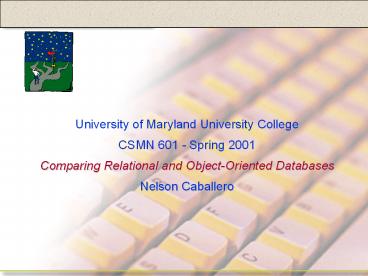University of Maryland University College - PowerPoint PPT Presentation
1 / 15
Title:
University of Maryland University College
Description:
Comparing Relational and Object-Oriented Databases ... Comparison between both models. Both models support ACID properties differently. ... – PowerPoint PPT presentation
Number of Views:21
Avg rating:3.0/5.0
Title: University of Maryland University College
1
- University of Maryland University College
- CSMN 601 - Spring 2001
- Comparing Relational and Object-Oriented
Databases - Nelson Caballero
2
Comparing Relational and Object-Oriented Databases
Hypothetical case scenario
- IT manager attends a corporate meeting.
- Problem Customer service complaints.
- Fact 1 Employees blame slow, antiquated and
difficult to use database. - Fact 2 Managers demand modern databases.
- Fact 3 No knowledge of technology used by
competitors. - Goal Improve services, remain competitive, and
increase revenue.
3
Comparing Relational and Object-Oriented Databases
- Presentation Agenda
- Relational and Object-Oriented Database Concepts
- Database Functionality
- Query Language
- Database Management System
- Selection Criteria
- Conclusion
4
Comparing Relational and Object-Oriented Databases
- Relational and Object-Oriented Concepts
What is a database?
- A collection of persistent data used by an
enterprise. (Date, C.) - Offers controls to modify data in shared
environments. - Data is independent of programs and users.
- Data elements are interrelated and stored
together.
Nelson Caballero - 4/16/2001
5
Comparing Relational and Object-Oriented Databases
- Relational and Object-Oriented Concepts
(Continued)
Relational Databases
- Introduced by Ted Codd of IBM Research in 1970.
- Data perceived by users as tables.
- Retrieval operations generate new tables from
other tables. - Concerned with data structure, integrity, and
manipulation.
Nelson Caballero - 4/16/2001
6
Comparing Relational and Object-Oriented Databases
- Relational and Object-Oriented Concepts
(Continued)
Object-Oriented Databases
- Support data abstraction, encapsulation, and
inheritance. - Allow object identification and communication.
- Reuse and modify objects.
- Deal with complex data types.
Nelson Caballero - 4/16/2001
7
Comparing Relational and Object-Oriented Databases
- Relational and Object-Oriented Concepts
(Continued)
Comparison between both models
- Both models support ACID properties differently.
- (Atomicity, Consistency, Isolation, and
Durability)
Nelson Caballero - 4/16/2001
8
Comparing Relational and Object-Oriented Databases
- Database Functionality
- Transactions.
- Recovery.
- Back up and restore.
- Concurrency and deadlock.
- Storage.
- Authorization and security.
Nelson Caballero - 4/16/2001
9
Comparing Relational and Object-Oriented Databases
- Database Functionality (Continued)
Database allows transactions, enforces security,
and concurrency based on user roles and
privileges.
Nelson Caballero - 4/16/2001
10
Comparing Relational and Object-Oriented Databases
- Query Language
A comprehensive database language with
statements for data definition, query, and
update. (Elmasri and Navathe)
Nelson Caballero - 4/16/2001
11
Comparing Relational and Object-Oriented Databases
- Database Management System
A software system that enables users to create
and maintain the database.
Nelson Caballero - 4/16/2001
12
Comparing Relational and Object-Oriented Databases
- Selection Criteria
It depends on the company
- Business needs and practices.
- Monetary constraints.
- Infrastructure and resources.
- Short and long term corporate goals.
Nelson Caballero - 4/16/2001
13
Comparing Relational and Object-Oriented Databases
- Selection Criteria (Continued)
IDC predicts a 12.5 revenuegrowth for
relational databasesand 18.5 for
object-orienteddatabases from 1999 to 2004.
Database industry Trends
Database technology
Revenue (Millions of US dollars)
Source IDC, 2000
Nelson Caballero - 4/16/2001
14
Comparing Relational and Object-Oriented Databases
- Conclusion
- Incorporating a new database technology requires
- Understanding of database, relational, and object
concepts. - Assessing database functionality.
- Assessing query language features.
- Studying DBMS efficiency.
- Selecting a technology based on business rules
and needs.
Nelson Caballero - 4/16/2001
15
Comparing Relational and Object-Oriented Databases
Sample OO databases on the Web
http//wwwqbic.almaden.ibm.com/cgi-bin/stamps-demo
http//www.hermitagemuseum.org/fcgi-bin/db2www/qb
icSearch.mac/qbic?selLangEnglishhttp//earth.jsc
.nasa.gov/
Nelson Caballero - 4/16/2001































